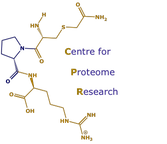A Brian Cox view of proteomics
13 03, 11
I’ve been thinking about the numbers in proteomics, and given the current enthusiasm for the Brian Cox (‘the Universe is like totally awesome’) TV series, it is worth thinking about the numbers that we deal with in cosmological terms.
First number — the Universe contains about half a mole of stars - 3 x10^23. There are as many stars in the Universe as there are molecules of common salt that you can comfortably hold as a small heap in the palm of your hand.
Second number — a good signal in a typical LC-MS/MS run would be given by, let’s say 300 fmol on column. This is equivalent to 2 * 10^11 molecules. The trouble is that we think of 300fmol as ‘not very much’. However, there are 300fmol of stars in the Milky Way! Find a patch of clear, cold air (harder and harder these days) and look up! Try and do the same through a telescope - you are still a long way from being able to see the entire 300fmol of stars that are in our galaxy.
Then, wonder about the fact that we have to spray a Milky Way’s* worth of a peptide into the ESI source of a mass spectrometer to obtain modest signals. Mass spectrometry (or at least, source design) has a long way to go!
Source re star numbers: [Wolfram Alpha]
p.s. for those who have trouble apply ‘mol’ to these objects - it is just a number. A typical audience in an international conference is, say 600 attendees - that’s equivalent to a zeptomol of participants. It seems to me that we could now classify conferences according to the size in mol. A big meeting (say, 20,000 attendees) is a ’33 zeptomol meeting’. A small local meeting (150 attendees) would be a ‘quarter zeptomol’ meeting.
I shall refrain from discussing the next prefix down in the series fmol, amol, zmol......it’s the worst mass spectrometrists’ joke in the world.
* Not the chocolate bar!
First number — the Universe contains about half a mole of stars - 3 x10^23. There are as many stars in the Universe as there are molecules of common salt that you can comfortably hold as a small heap in the palm of your hand.
Second number — a good signal in a typical LC-MS/MS run would be given by, let’s say 300 fmol on column. This is equivalent to 2 * 10^11 molecules. The trouble is that we think of 300fmol as ‘not very much’. However, there are 300fmol of stars in the Milky Way! Find a patch of clear, cold air (harder and harder these days) and look up! Try and do the same through a telescope - you are still a long way from being able to see the entire 300fmol of stars that are in our galaxy.
Then, wonder about the fact that we have to spray a Milky Way’s* worth of a peptide into the ESI source of a mass spectrometer to obtain modest signals. Mass spectrometry (or at least, source design) has a long way to go!
Source re star numbers: [Wolfram Alpha]
p.s. for those who have trouble apply ‘mol’ to these objects - it is just a number. A typical audience in an international conference is, say 600 attendees - that’s equivalent to a zeptomol of participants. It seems to me that we could now classify conferences according to the size in mol. A big meeting (say, 20,000 attendees) is a ’33 zeptomol meeting’. A small local meeting (150 attendees) would be a ‘quarter zeptomol’ meeting.
I shall refrain from discussing the next prefix down in the series fmol, amol, zmol......it’s the worst mass spectrometrists’ joke in the world.
* Not the chocolate bar!
